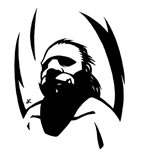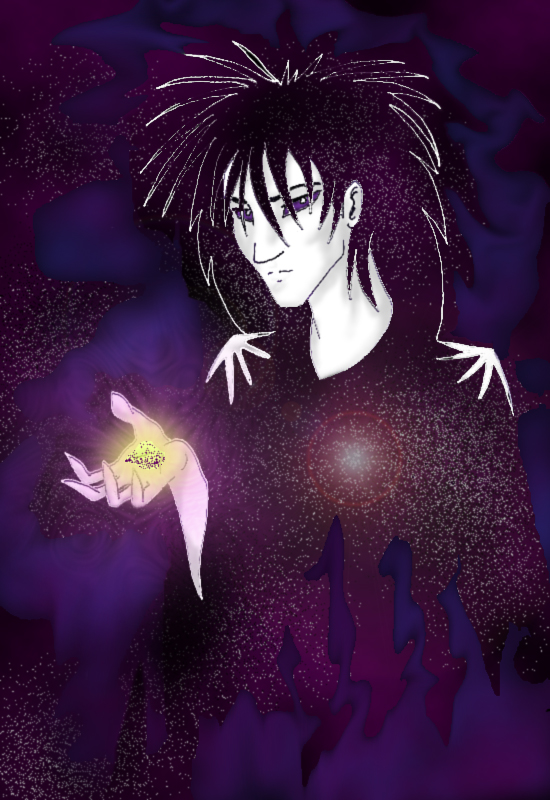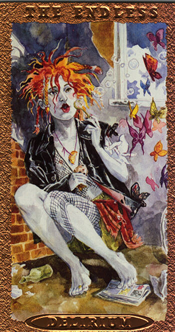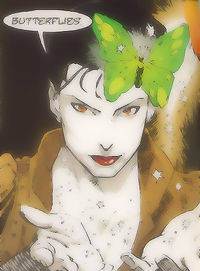IAFoL - it.arti.fumetti on line
The SANDMAN, Master of Dreams
Famiglia di Endless
 Sulla genesi della famiglia di Endless, è possibile andare oltre,
ipotizzando che dopo l'evoluzione da Destino in Morte, Sogno, Distruzione e quindi
Desiderio, l'appagamento iniziale del Desiderio possa cagionare Delizia, ma la troppa
Delizia o il suo cessare muta presto in Disperazione che genera il Deliro. E questo in un
ciclo continuo, fino alla fine dell'eternità, quando prima il Deliro
terminerà, facendo cessare la Disperazione, che annullerà ogni Desiderio
rendendo inutile ogni ulteriore Distruzione. E tutto ciò spegnerà il Sogno,
allorchè anche il Destino chiuderà il suo libro e la Morte, rimasta sola,
cesserà anch'essa di esistere. Sulla genesi della famiglia di Endless, è possibile andare oltre,
ipotizzando che dopo l'evoluzione da Destino in Morte, Sogno, Distruzione e quindi
Desiderio, l'appagamento iniziale del Desiderio possa cagionare Delizia, ma la troppa
Delizia o il suo cessare muta presto in Disperazione che genera il Deliro. E questo in un
ciclo continuo, fino alla fine dell'eternità, quando prima il Deliro
terminerà, facendo cessare la Disperazione, che annullerà ogni Desiderio
rendendo inutile ogni ulteriore Distruzione. E tutto ciò spegnerà il Sogno,
allorchè anche il Destino chiuderà il suo libro e la Morte, rimasta sola,
cesserà anch'essa di esistere.
Da notare che ogni entità à anche
artefice del suo contrario. Morte esiste perchè esiste la nascita, la vita, quindi
incarna in sè stessa anche questo aspetto, così come Distruzione incarna in
sè l'Amore e l'atto creativo. Questi aspetti sono sottilmente presenti in diversi momenti dell'opera.
Sempre Gaiman ritiene che molti di coloro che incorporano gli Endless nelle loro personali mitologie, lo fanno perchè queste entità sono personificazioni antropomorfiche di cose che certe volte è molto importante poter riuscire a personificare in forma umana. Lui stesso ha creato Morte pensando a come egli voleva veder rappresentato questo concetto. "Nel momento in cui guarderò dall'alto questo corpo distrutto, voglio qualcuno sensibile e piacevole che dica: 'Sai, dovevi proprio guardare da entrambni i lati della strada, prima di attraversare!'. E non un qualche scheletro che mi fa solo impaurire. Voglio qualcuno che sia bravissimo nel farlo, qualcuno che l'abbia fatto ovviamente per moltissimo tempo."
Ricorda Gaiman in una intervista:
HB: You kicked off the Brief Lives collection with this introduction for new readers: "There are seven beings that aren't gods. Who existed before humanity dreamed of gods and will exist after the last god is dead. They are called The Endless. They are embodiments of (in order of age) Destiny, Death, Dream, Destruction, Desire, Despair, and Delirium." How did you come to create the Endless?
NG: When DC gave me a monthly comic to write, one of the first things I had to deal with was knowing I don't have what it takes to do super-hero stories, even though that's what the vast majority of comics buyers like to read. People such as Alan Moore, Grant Morrison, and Kurt Busiek can write super heroes beautifully, but I'm just no good at it.
On the other hand, I can write science fiction, fantasy, and horror. So I decided to find a way to cheat my way through-that is, to come up with characters who look enough like super heroes to entice a comics reader into giving them a try, but who really aren't super heroes at all.
That made me think of Lord of Light, a 1967 novel by Roger Zelazny. The book struck me as a very interesting model, because it's about people who take on the attributes of Hindu gods, constituting, in effect, a heavenly Legion of Super-Heroes. I liked that approach, but I decided to take it a step further--instead of writing about humans acting as gods, why not just write about gods?
Per quanto riguarda il look di Sandman, così l'autore spiega in questa intervista le scelte e le fonti di ispirazione:
 HB: Where did the Sandman's "rock star" appearance come from? HB: Where did the Sandman's "rock star" appearance come from?
NG: I wanted him to look like royalty. In the late 1980s, kings and queens were dressing and behaving like ordinary people, and I felt it was celebrities-and especially rock stars-who were our true royalty. I made some drawings with that in mind, and with the Sandman dressed in a black kimono I ran across in a book of Japanese design. I sent those off to Sam Kieth, who was the first issue's penciller, and Sam developed the Dream we see in issue 1. Then Mike Dringenberg, who was inking the first issue, said, "Hey, he looks like Peter Murphy from Bauhaus." Dave McKean and I got some Bauhaus videos and immediately saw that Mike was right; and Dave ended up making the central image on the cover of Sandman 1 a Peter Murphy-like face.
HB: Dave also did an early Sandman drawing based on Bono's appearance in the Clannad music video "In a Lifetime” The illustration is reproduced on the first page of the afterword to Preludes & Nocturnes.
NG: I should add that the Sandman's look also sprung from my wanting to convey a brooding, adolescent alienation, the kind you typically get when you're sixteen-the sort of attitude, for example, Dream displays in chapter 2 of Brief Lives when he's standing on a balcony getting rained on for days on end just because a girl dumped him.
HB: Some have suggested another influence was Michael Moorcock's Elric- a tall, thin albino prince who traffics in magic and dark forces, and has a soul-eating sword that behaves similarly to Dream's ruby after it was altered by Dr. Dee.
NG: It doesn't ring true for me. For example, Elric frequently agonizes over his past actions, while Dream is the least introspective character I've ever written. As for the ruby, it was normally a kind of computer that automated things for the Sandman; instead of having to figure out how to perform a certain task, Dream would just say, "Ruby, do this" and it was done. And the Sandman's chalk white skin was, quite simply, a coloring mistake. In my script for issue 1, I described Dream as being pale and light-skinned-which is the way he appears in the Dave McKean portrait on the cover.
Michael Zulli ricorda che Gaiman descrisse Daniel come Sandman a 16 anni, con un po' meno esperienza, non pienamente cresciuto, con un'aria da ragazzo, ma vecchio abbastanza da possedere autorità.
Gaiman: “Alcuni aspetti di Tori Amos confluirono in Delirio, ma solo successivamente. Ci sono vignette in Vite brevi dove Delirio ha una netta somiglianza con Tori. Al contrario di alcune leggende metropolitane, comunque, non ho incontrato Tori e poi creato Delirio come conseguenza: Delirio esisteva anni prima che ci incontrassimo. Ovviamente in Delirio c'è molto anche di Jill Thompson, perché lei l'ha disegnata più di ogni altra persona. Molto del manierismo di Delirio, i modi in cui atteggia il suo corpo e così via sono tutte cose che Jill fa normalmente. Ma la verità è che Delirio è me stesso. Solo io in silenzio che ascolto. Ed è questa la cosa che mi è piaciuta di più di lei.”
 Ecco come Neil stesso descrive l'aspetto di Delirio: Ecco come Neil stesso descrive l'aspetto di Delirio:
She has sort of Toriish lips that quirk up at the ends, and lank, multicoloured hair, and multicoloured eyes, and little fish and stars and squiggles in the air around her.
Delirio in verità è già passata attraverso grossi cambiamenti; come rivelato nel numero 21, Delirio nacque come Delizia. Maggiori informazioni riguardo questo aspetto sono fornite nel secondo capitolo di Vite Brevi a pagina 20 che mostrano una giovane Delizia innocente come un bambino. Delirio ricorda la trasformazione, il momento in cui realizzò cosa stava succedendo, che l'universo stava cambiando, che lei stava crescendo o comunque diventando più vecchia. Ricorda anche di essersi rivolta a Distruzione in cerca di aiuto, il quale l'ha confortata fino a quando lei si calmò. Da questo si può desumere che Distruzione era l'unico membro della sua famiglia che ha mostrato nei confronti di Delirio gentilezza e comprensione. Dopotutto chi ne sa di più riguardo ai cambiamenti di potere? Possiamo anche immaginare che Distruzione forni una forza stabilizzatrice che, data la sua capacità di scindersi in farfalle, Delirio cercava disperatamente.
Il disegnatore Mike Dringenberg racconta la nascita grafica di questo personaggio:
"Delirio inizialmente derivò da una ragazza che Neil ci indicò in una rivista inglese di body piercing, quella piccola ambigua fotografia fu scattata in un locale. La cosa strana è che all'epoca la fotografia nella foto aveva una incredibile rassomiglianza con la ragazza con cui stavo in quel momento. È la cosa mi colpì moltissimo. Così la chiamai e le chiesi di posare per vari schizzi che feci di Delirio. Era perfetta per questo. Ma Jill creò la Delirio definitiva."
Distruzione. “Ho sempre pensato a Distruzione come a Brian Blessed, il bravo attore che ha interpretato re Riccardo Quarto. Un personaggio robusto, con la barba cui piaceva ridere. Ha anche avuto il ruolo del principe Vultan, l'uomo alato, nel remake di Flash Gordon nel 1980. La sua risata di cuore è veramente memorabile.” (Neil Gaiman)
Ancora Mike Dringenberg svela alcuni retroscena grafici: "Fu il personaggio per me più facile, perché mi sono basato sul mio miglior amico, un ragazzone irlandese dai capelli rossicci, con una folta barba. La cosa divertente è che assomiglia moltissimo al ragazzo di Jill Thompson, perlomeno sotto l'aspetto fisico. Quindi dopo che creai il personaggio, in un paio di poster e in altre due o tre vignette qui e là, quando poi Jill dovette fare la maggior parte del lavoro riguardo Distruzione, divenne facile anche a lei disegnarlo. Fu veramente una coincidenza estremamente fortunata."
Sempre riguardo a questo personaggio, riportiamo altre considerazioni fatte dall'autore:
[Nel ciclo Vite Brevi] The Sandman asks Destruction why he abandoned his realm three hundred years ago, in 1695. Part of the answer was actually revealed back in chapter 4: in a flashback sequence occurring around 1685, Destruction is shown to be uneasy about the path begun by Isaac Newton's study of "opticks" because he realizes that Newton's question "Are not light and gross bodies intraconvertible?" will inevitably lead to the development of the atomic bomb. It's a scenario Destruction has seen many times before, on many worlds; but he's grown fond of Earth, and he appears reluctant to experience another cycle of "the flames, the big bang, the loud explosions."
Destruction then continues: "Destruction did not cease with my abandonment of my realm, no more than people would cease to dream should you abandon yours. Perhaps it's more uncontrolled, wilder. Perhaps not. But it's no longer anyone's responsibility. As this universe came into being Destiny came with it, alone in the darkness. Before the first living thing came into existence, our sister was there, waiting". Readers with excellent memories will recognize this comment as very similar to Death's own words in Sandman 20: "When the first living thing existed, I was there, waiting." But the subtle difference between the two statements "before" versus "when" is literally the difference between life and death. It's also no coincidence that Destruction was the first character to reveal his older sister's dual nature (on page 19 of "The Song of Orpheus"); and that Sandman 20 is about Ramie Blackwell, a person who refuses to let go of her old identity and, as a result, dies.
Destruction is indicating that, without exception, all must make way for change; or, as he puts it to the Sandman, "One cannot begin a new dream without abandoning the last, eh brother?" Like Death's advice to Rainie Blackwell in issue 20, these words can be interpreted in multiple ways. One can hear them as an exhortation for the Sandman to radically alter himself; or as an encouragement for Sandman to follow his brother's lead and abandon his realm; or as an invitation for Dream to commit suicide."
 Desiderio. “Ci sono state due ispirazioni visuali per desiderio. La prima grazie alle stampe sexy e androgine create dall'artista Patrick Nagel, che all'inizio degli anni ‘80 sembravano essere dappertutto. La seconda riferita alla rock star Annie Lennox, più o meno nel 1987, quando cantava ancora con gli Eurythmics. Quando vedevo un video musicale suo, non mi interessava sapere se Annie era un ragazzo o una ragazza: era semplicemente stupenda. Desiderio. “Ci sono state due ispirazioni visuali per desiderio. La prima grazie alle stampe sexy e androgine create dall'artista Patrick Nagel, che all'inizio degli anni ‘80 sembravano essere dappertutto. La seconda riferita alla rock star Annie Lennox, più o meno nel 1987, quando cantava ancora con gli Eurythmics. Quando vedevo un video musicale suo, non mi interessava sapere se Annie era un ragazzo o una ragazza: era semplicemente stupenda.
Bisogna tenere a mente che Desiderio in tutta onestà odia Sogno, e Sogno non apprezza Desiderio a sua volta. Hanno due personalità che si scontrano continuamente. Ora, il fatto che Desiderio compaia in una storia che vede come protagonista Sandman, la fa apparire come il personaggio cattivo, ma se dovessi scrivere la stessa storia dal punto di vista di Desiderio, i lettori vedrebbero fino a che punto lui/lei percepisce Sandman come insopportabilmente irritante, soffocante e pieno di sé, e Sandman inizierebbe a sembrare come il personaggio negativo.”
Mike Dringenberg: "Per quanto riguarda Desiderio, la grande statua gigante dove vive assomiglia un po' alla moda degli anni 80 in ambito pop music, in particolare ad Annie Lennox, ma in verità il modello era la mia ragazza dell'epoca. Gaiman vedeva Desiderio come qualcosa fra David Bowie e Annie Lennox, ma io ho sempre pensato più in termini di Duran Duran, una specie quasi bidimensionale e vagamente scialba."
Sempre lo stesso disegnatore ricorda altri dettagli dei restanti familiari. "Per quanto riguarda come Gaiman mi descrisse il personaggio di Morte, io non ho mai visto il disegnino che sicuramente egli fece, ma da come me la descrisse era qualcosa di molto simile a Louise Brooks. Voleva quel look, con una specie di corta bombetta nera, con uno stile particolare. Il personaggio è basato principalmente su Cinnamon, che era una ballerina, ma anche su un paio di altre persone che conoscevo. Anche la mia ragazza all'epoca ha posato in diverse occasioni per quel personaggio.
La croce ansata di Death fu in verità una mia idea. Per due ragioni. La prima derivante da un passaggio di Yragael/Urm di Philippe Druillet, che recita "solo i mortali muoiono per sempre", una frase che ho ripetuto in una incisione su una tomba nella pagina dedicata a Death nel Who's Who della DC. Inoltre poiché Death era una eterna e Cinnamon era solita indossare una piccola croce ansata in argento come segno di immortalità e di rinascita, ho pensato che entrambi erano due tributi appropriati alla bellezza e alla piacevole ironia degni di questa divinità, una specie di scherzo cosmico".
Disperazione. "Gaiman trovò un fotografia di una freak in un circo, con i denti inferiori sporgenti. Non ho idea quando fu scattata la foto. Era una vecchia immagine in bianco e nero di cui egli fece una copia e me la mandò. Quindi io rimasi praticamente aderente a quella foto perché era veramente una bellissima immagine spaventevole. Probabilmente oggi la gestirei in modo migliore, ma allora ho praticamente disegnato il personaggio meccanicamente, senza pensarci troppo. Disperazione è sempre stata un po' diversa, per certi versi, credo perché Gaiman ebbe un approccio particolarmente personale all'intera idea di disperazione."
Per quanto riguarda il lettering, lasciamo la parola al maestro Todd Klein, che assieme all'autore e al copertinista è la persona che ha seguito più a lungo l'intera serie:
"The border of a Sandman word balIoon has a blottiness that conveys Morpheus's shifting nature. Also, the letters are upper and lowercase, and reversed that is, white letters on black. The latter effect was created by DC's production departement, which made negatives of my lettering and then pasted it over each original."
Delirium was a different challenge. "Her lettering constantly changes in size, shape, and slant, wobbling in and out, to indicate that she's always on the verge of madness”. "Her balloons also contain a variety of rainbow colours, which was my idea but executed by colorist Danny Vozzo."
In contrast, "Destiny speaks in all italics, which helps convey the emotionless quality of his voice. And Desires lettering is in the style of Art Nouveau posters and ads, to make him-her look like a Patrick Nagel painting."
For other Endless, a plainer style was more appropriate. "Destruction simply has heavy lettering, surrounded by a heavy black border, to give the impression that he speaks very loudly and forcefully. Despair has normal lettering but a very ragged border. And Death speaks in standard word ballons lo express her down-toearth personality, that she acts like she's just another person."
Ulteriori dettagli sul lettering ci vengono offerti in questa intervista:
The first unique lettering style to surface in Sandman was Dream's. Was it your idea to have the white lettering on the black background?
No, actually I was against that. That was a production effect. I lettered it normally and a negative copy was made in DC's production department, and pasted on top. I did letter it with a heavier pen because I knew they were going to do that, so I thought that would give it a better chance of reproducing. But I still felt that with the variation in reproduction and with the variation in the darkness of the letters the way they were copied, I felt it would be hard to read in places, and it was, actually. But Karen really liked that idea and she really wanted to go with it, so they did it. Of course, now I can do it myself on the computer and get a more consistent look, because I can control how wide the letters are. Before, when they were making photographic copies, it depended upon the exposure. If they overexposed it, the letters were too thin. If they underexposed it, they were too wide and kind of ran together. If you look through the collections, you'll see cases of that.
One of the most interesting lettering styles you developed was for Mathew, the raven with the lines of the letters overlapping and creating the image of scattered sticks.
Exactly. That’s what I was going for - you drop a bunch of pick-up sticks on the ground and it spells out some letters. That’s the effect I was going for. And Mathew’s a raven, who has a kind of rough, scratchy voice, so that was a part of it. Also, I just felt it gave it an untidy look that matched his character, an untidy approach to life, I think.
What was Nei/'s input in this case? Did he say something like, "Have him speak in a scratchy manner"?
I couldn't say for sure, but that’s probably what happened. I don't remember exactly what Neil asked for, but I know he asked for something. One thing that he did ask for - on "A Dream of a Thousand Cats" [issue 18], he wanted to come up with a concept where we wouldn't have the animals actually speaking. So we came up with a combination of a thought balloon and a speech balloon, so it would have some aspects of both. We used that in a few other places as well. That was Neil's concept.
Si è a lungo discusso se il fatto che in inglese i nomi di queste
entità inizino tutti con le lettere "De" (tranne Dream!) fosse un messaggio
particolare di Gaiman o una semplice coincidenza. Una risposta chiara pare che non sia mai
stata fornita, nemmeno dallo stesso autore.
Per altri spunti di discussione, in particolare sulle gemelle Desiderio e Disperazione, è possibile leggere in inglese questo thread apparso sul gruppo di discussione dedicato a Neil: alt.fan.neil-gaiman
In questa pagina ripropongo, in inglese, delle introduzioni di Neil Gaiman stesso, di Tori Amos e di Tom Peyer sul personaggio forse più carismatico della Famiglia: Death.

|
 Sulla genesi della famiglia di Endless, è possibile andare oltre,
ipotizzando che dopo l'evoluzione da Destino in Morte, Sogno, Distruzione e quindi
Desiderio, l'appagamento iniziale del Desiderio possa cagionare Delizia, ma la troppa
Delizia o il suo cessare muta presto in Disperazione che genera il Deliro. E questo in un
ciclo continuo, fino alla fine dell'eternità, quando prima il Deliro
terminerà, facendo cessare la Disperazione, che annullerà ogni Desiderio
rendendo inutile ogni ulteriore Distruzione. E tutto ciò spegnerà il Sogno,
allorchè anche il Destino chiuderà il suo libro e la Morte, rimasta sola,
cesserà anch'essa di esistere.
Sulla genesi della famiglia di Endless, è possibile andare oltre,
ipotizzando che dopo l'evoluzione da Destino in Morte, Sogno, Distruzione e quindi
Desiderio, l'appagamento iniziale del Desiderio possa cagionare Delizia, ma la troppa
Delizia o il suo cessare muta presto in Disperazione che genera il Deliro. E questo in un
ciclo continuo, fino alla fine dell'eternità, quando prima il Deliro
terminerà, facendo cessare la Disperazione, che annullerà ogni Desiderio
rendendo inutile ogni ulteriore Distruzione. E tutto ciò spegnerà il Sogno,
allorchè anche il Destino chiuderà il suo libro e la Morte, rimasta sola,
cesserà anch'essa di esistere.  HB: Where did the Sandman's "rock star" appearance come from?
HB: Where did the Sandman's "rock star" appearance come from? Ecco come Neil stesso descrive l'aspetto di Delirio:
Ecco come Neil stesso descrive l'aspetto di Delirio: Desiderio. “Ci sono state due ispirazioni visuali per desiderio. La prima grazie alle stampe sexy e androgine create dall'artista Patrick Nagel, che all'inizio degli anni ‘80 sembravano essere dappertutto. La seconda riferita alla rock star Annie Lennox, più o meno nel 1987, quando cantava ancora con gli Eurythmics. Quando vedevo un video musicale suo, non mi interessava sapere se Annie era un ragazzo o una ragazza: era semplicemente stupenda.
Desiderio. “Ci sono state due ispirazioni visuali per desiderio. La prima grazie alle stampe sexy e androgine create dall'artista Patrick Nagel, che all'inizio degli anni ‘80 sembravano essere dappertutto. La seconda riferita alla rock star Annie Lennox, più o meno nel 1987, quando cantava ancora con gli Eurythmics. Quando vedevo un video musicale suo, non mi interessava sapere se Annie era un ragazzo o una ragazza: era semplicemente stupenda.